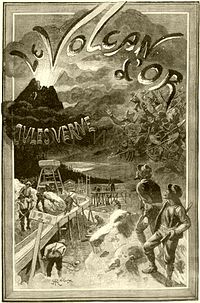Plot
Two Canadians, Summy Skim and Ben Raddle, are unexpectedly bequeathed a mining claim in the Klondike. [3] They encounter many things such as disaster, disease, and extreme weather. On the way back to Montreal, where the two cousins reside, Ben Raddle and Summy Skim are trapped in a large flood that floods the entire Klondike. Ben has a disease and a broken leg, and needs to be taken to the hospital to be seen by the trustful Dr. Pilcox. Summy Skim and their guide, Bill Steel, bring the unfortunate man to the hospital, where he is healed a few months later.
On the way out to a hunt, Summy Skim, Bill Steel, and the trusted Indian, Neluto, discover a man, torn apart, and lying under a tree. They come to the man's rescue, and bring him back to the hospital, where he dies a few days later. Before he dies, the man tells Ben Raddle and Summy Skim of a volcano of pure gold named the "Golden Mount". The cousins and their guides then get a caravan together to return to the Golden Mount. While out on a hunt, Summy Skim and Neluto discover the two villains and their caravan, plotting to take over the volcano.
Summy Skim and Neluto return to camp, where they tell the others, and a plan is formulated. Ben Raddle plans to force the volcano to erupt by emptying the river into a hole he will dig into the volcano. The plan succeeds; the villains, having made their way to the top of the mountain, are immediately forced down by the eruption. Summy Skim shoots the Texans, Hunter and Malone, the leader of the villains. The volcano erupts into the sea, causing Summy Skim and Ben Raddle to leave with less money than they came with.

Jules Gabriel Verne was a French novelist, poet, and playwright. His collaboration with the publisher Pierre-Jules Hetzel led to the creation of the Voyages extraordinaires, a series of bestselling adventure novels including Journey to the Center of the Earth (1864), Twenty Thousand Leagues Under the Seas (1870), and Around the World in Eighty Days (1872). His novels, always well-researched according to the scientific knowledge then available, are generally set in the second half of the 19th century, taking into account the technological advances of the time.

The Municipality and Borough of Skagway is a first-class borough in Alaska on the Alaska Panhandle. As of the 2020 census, the population was 1,240, up from 968 in 2010. The population doubles in the summer tourist season in order to deal with the large number of summer tourists each year. Incorporated as a borough on June 25, 2007, it was previously a city in the Skagway-Yakutat-Angoon Census Area. The most populated community is the census-designated place of Skagway.

Captain Nemo is a character created by the French novelist Jules Verne (1828–1905). Nemo appears in two of Verne's science-fiction books, Twenty Thousand Leagues Under the Seas (1870) and The Mysterious Island (1875). He also makes a brief appearance in a play written by Verne with the collaboration of Adolphe d'Ennery, Journey Through the Impossible (1882).

The Klondike Gold Rush was a migration by an estimated 100,000 prospectors to the Klondike region of Yukon, in north-western Canada, between 1896 and 1899. Gold was discovered there by local miners on August 16, 1896; when news reached Seattle and San Francisco the following year, it triggered a stampede of prospectors. Some became wealthy, but the majority went in vain. It has been immortalized in films, literature, and photographs.

From the Earth to the Moon: A Direct Route in 97 Hours, 20 Minutes is an 1865 novel by Jules Verne. It tells the story of the Baltimore Gun Club, a post-American Civil War society of weapons enthusiasts, and their attempts to build an enormous Columbiad space gun and launch three people – the Gun Club's president, his Philadelphian armor-making rival, and a French poet – in a projectile with the goal of a Moon landing. Five years later, Verne wrote a sequel called Around the Moon.
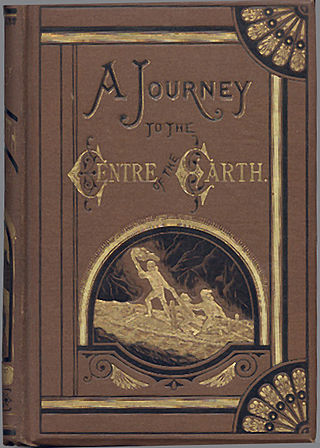
Journey to the Center of the Earth, also translated with the variant titles A Journey to the Centre of the Earth and A Journey into the Interior of the Earth, is a classic science fiction novel by Jules Verne. It was first published in French in 1864, then reissued in 1867 in a revised and expanded edition. Professor Otto Lidenbrock is the tale's central figure, an eccentric German scientist who believes there are volcanic tubes that reach to the very center of the earth. He, his nephew Axel, and their Icelandic guide Hans rappel into Iceland's celebrated inactive volcano Snæfellsjökull, then contend with many dangers, including cave-ins, subpolar tornadoes, an underground ocean, and living prehistoric creatures from the Mesozoic and Cenozoic eras. Eventually the three explorers are spewed back to the surface by an active volcano, Stromboli, located in southern Italy.

The Mysterious Island is a novel by Jules Verne, serialised from August 1874 to September 1875 and then published in book form in November 1875. The first edition, published by Hetzel, contains illustrations by Jules Férat. The novel is a crossover sequel to Verne's famous Twenty Thousand Leagues Under the Seas (1870) and In Search of the Castaways (1867–68), though its themes are vastly different from those books. An early draft of the novel, rejected by Verne's publisher and wholly reconceived before publication, was titled Shipwrecked Family: Marooned with Uncle Robinson, indicating the influence of the novels Robinson Crusoe and The Swiss Family Robinson. Verne developed a similar theme in his novel, Godfrey Morgan.
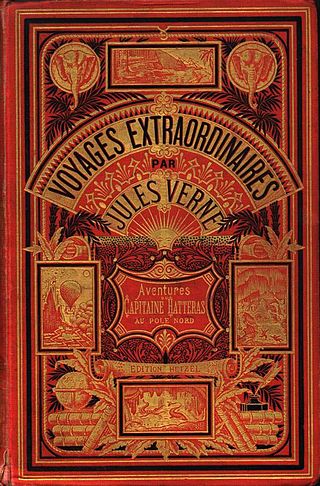
The Voyages extraordinaires is a collection or sequence of novels and short stories by the French writer Jules Verne.

The Chilkoot Trail is a 33-mile (53 km) trail through the Coast Mountains that leads from Dyea, Alaska, in the United States, to Bennett, British Columbia, in Canada. It was a major access route from the coast to Yukon goldfields in the late 1890s. The trail became obsolete in 1899 when a railway was built from Dyea's neighbor port Skagway along the parallel White Pass trail.

Michael Strogoff: The Courier of the Czar is a novel written by Jules Verne in 1876. Critic Leonard S. Davidow, considers it one of Verne's best books. Davidow wrote, "Jules Verne has written no better book than this, in fact it is deservedly ranked as one of the most thrilling tales ever written." Unlike some of Verne's other novels, it is not science fiction, but its plot device is a scientific phenomenon. The book was later adapted to a play, by Verne himself and Adolphe d'Ennery. Incidental music to the play was written by Alexandre Artus in 1880 and by Franz von Suppé in 1893. The book has been adapted several times for films, television and cartoon series.
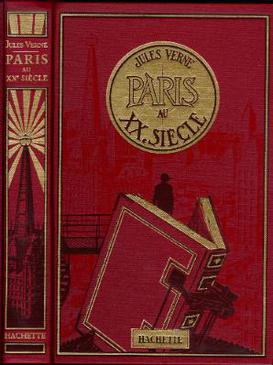
Paris in the Twentieth Century is a science fiction novel by Jules Verne. The book presents Paris in August 1960, 97 years in Verne's future, when society places value only on business and technology.

Golden Nuggets are a breakfast cereal sold in the UK and Ireland by Cereal Partners. It is made mainly from cereal grains, sugar and honey, formed into large yellow crunchy balls. It has a sweet, slightly honey-like flavour. The taste has been described as similar to the American cereal Cap'n Crunch.

Michel Jean Pierre Verne was a writer, editor, and the son of Jules Verne.

Les Indes noires is a novel by the French writer Jules Verne, serialized in Le Temps in March and April 1877 and published immediately afterward by Pierre-Jules Hetzel. The first UK edition was published in October 1877 by Sampson Low, Marston, Searle and Rivington as The Child of the Cavern, or Strange Doings Underground. Other English titles for the novel include Black Diamonds and The Underground City.

Facing the Flag or For the Flag is an 1896 patriotic novel by Jules Verne. The book is part of the Voyages extraordinaires series.
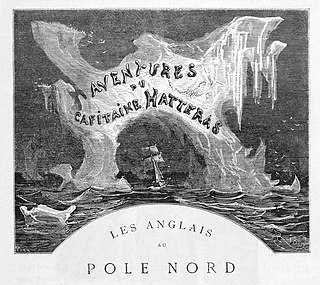
The Adventures of Captain Hatteras is an 1864 adventure novel by Jules Verne in two parts: The English at the North Pole and The Desert of Ice.

The Chase of the Golden Meteor is a novel by Jules Verne. It was one of the last novels written by the prolific French hard science fiction pioneer. The book, however, is seen as less an early example of hard science fiction than a social satire lampooning greed, monomania and vanity. Verne first wrote La Chasse au météore in 1901 and then rewrote it before his death, but it was only published in 1908, three years after the author's death, one of seven such posthumous novels.
French science fiction is a substantial genre of French literature. It remains an active and productive genre which has evolved in conjunction with anglophone science fiction and other French and international literature.
The Klondike Gold Rush is commemorated through film, literature, historical parks etc.
The Police Trail was built across parts of northern British Columbia as an alternate, overland route to the Yukon gold fields in 1897. It was used by only a few miners during the Yukon gold rush and fell into disrepair, but parts are still used by local hunting guides, hunters, outfitters and trappers.
